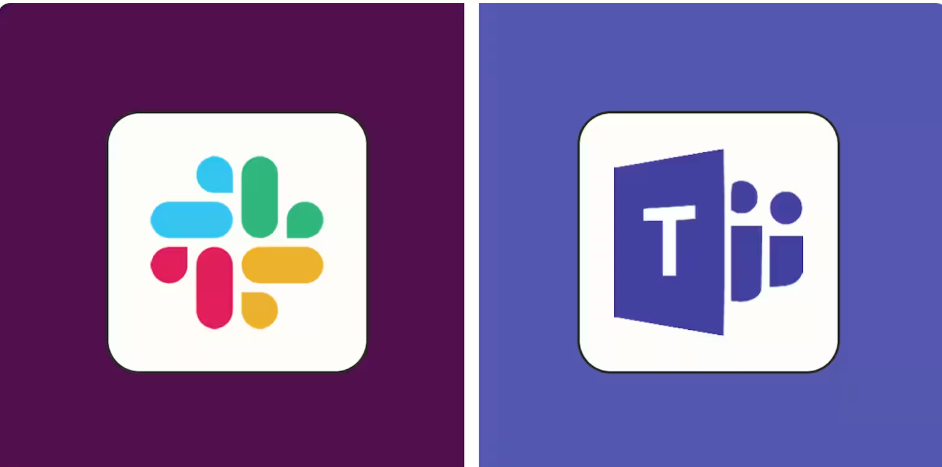In today’s digital workspace, real-time communication and collaboration tools are no longer a luxury – they’re a necessity. Businesses, both small and large, rely on tools like Slack and Microsoft Teams to keep teams aligned, improve productivity, and streamline communication.
But with both platforms offering powerful features, integrations, and cloud-based tools, how do you decide which one is right for your team?
Contents
- 1 Overview of Slack and Microsoft Teams
- 2 User Interface and Ease of Use
- 3 Communication Tools and Features
- 4 File Sharing and Collaboration
- 5 Integration with Third-Party Apps
- 6 Pricing and Plans
- 7 Security and Compliance
- 8 Performance and Reliability
- 9 Use Cases and Best Fit
- 10 Slack or Microsoft Teams?
- 11 Making the Right Collaboration Choice
Overview of Slack and Microsoft Teams

What Is Slack?
Slack is a cloud-based messaging app designed for team communication. It organizes conversations into channels, allowing teams to chat, share files, make calls, and integrate with a wide array of third-party apps.
Launched in 2013, Slack has become synonymous with modern workplace communication.
Key Slack Features:
- Organized channels
- Direct messaging
- File sharing
- Voice and video calls
- Powerful integrations (2,400+ apps)
- Workflow automation
What Is Microsoft Teams?
Microsoft Teams is part of the Microsoft 365 suite. It offers similar collaboration capabilities as Slack but is more tightly integrated with Microsoft’s tools like Word, Excel, and Outlook.
Key Microsoft Teams Features:
- Team-based channels and threads
- Direct messaging
- Deep integration with Microsoft 365 apps
- File storage via SharePoint
- Video conferencing and scheduling
User Interface and Ease of Use
Slack’s UI: Clean and Intuitive
Slack has a sleek and user-friendly interface. Users find it easy to navigate between channels, threads, DMs, and integrations. Custom emojis, slash commands, and bot automation add a layer of personality.
Pros:
- Minimal learning curve
- Easy customization
- Great onboarding for new users
Microsoft Teams’ UI: Feature-Rich but Dense
Teams offers a robust interface, especially for organizations already using Microsoft 365. However, its layout can feel cluttered to new users.
Pros:
- All-in-one workspace
- Strong search functionality
Cons:
- Slightly steeper learning curve
- Navigation can be overwhelming for first-time users
Winner: Slack for simplicity and user-first design.
Communication Tools and Features
Slack Communication Capabilities
- Channels for topics, departments, or projects
- Threads to prevent message overload
- Direct messages and group DMs
- Voice and video calls (up to 15 participants)
- Workflow Builder for automations
Microsoft Teams Communication Capabilities
- Teams and channels based on departments or projects
- Threads and mentions
- Direct messages and group chats
- Robust video conferencing (up to 1,000 attendees)
- Meeting scheduler and calendar integration
Winner: Microsoft Teams for enterprise-level communication features and meetings.
File Sharing and Collaboration
Slack File Sharing
- Drag-and-drop uploads
- File preview within the app
- Integrated with Google Drive, Dropbox, Box
- 5GB storage per user on free plan
Microsoft Teams File Sharing
- Integrated with SharePoint and OneDrive
- Real-time co-authoring of Office documents
- Secure file storage and organization
- 1TB+ storage with business plans
Winner: Microsoft Teams for its built-in document collaboration.
Integration with Third-Party Apps
Slack Integrations
Slack has over 2,400 third-party integrations. From project management (Asana, Trello) to customer support (Zendesk), Slack’s App Directory is unmatched.
Microsoft Teams Integrations
Teams has fewer third-party integrations (~700+), but deeply supports Microsoft 365 apps like Word, Excel, Outlook, OneNote, and Planner.
Winner: Slack for variety and flexibility in integrations.
Pricing and Plans
Slack Pricing
- Free: 90-day message history, 10 integrations
- Pro ($7.25/user/month): Unlimited history, voice/video calls
- Business+ ($12.50/user/month): SSO, compliance exports
- Enterprise Grid: Custom pricing for large organizations
Microsoft Teams Pricing
- Free: Unlimited chat and video calls, 5GB storage per user
- Microsoft 365 Business Basic ($6/user/month): Includes Teams + web/mobile Office apps
- Business Standard ($12.50/user/month): Adds desktop Office apps
- Enterprise plans: Advanced security, analytics, and admin tools
Winner: Microsoft Teams for more features at a lower entry cost, especially if you already use Microsoft 365.
Security and Compliance
Slack Security Features
- Data encryption in transit and at rest
- SSO and two-factor authentication
- Enterprise-grade compliance (SOC 2, ISO/IEC 27001)
Microsoft Teams Security Features
- Built-in Microsoft security and compliance tools
- Data loss prevention
- Advanced threat protection
- HIPAA, GDPR, and FedRAMP compliance
Winner: Microsoft Teams for superior enterprise-grade security and compliance options.
Performance and Reliability
Slack Reliability
- 99.99% uptime
- Fast performance on web, desktop, and mobile
- Lightweight app size
Microsoft Teams Reliability
- 99.9% uptime
- Strong backend infrastructure via Azure
- Heavier app may slow down older systems
Winner: Slack for lightweight, fast, and reliable experience across devices.
Use Cases and Best Fit
Slack Is Best For:
- Startups and SMBs
- Companies needing flexible integrations
- Teams favoring simplicity and customization
Microsoft Teams Is Best For:
- Large enterprises
- Businesses already on Microsoft 365
- Organizations with heavy video conferencing needs
Slack or Microsoft Teams?
Choosing between Slack and Microsoft Teams comes down to your business needs:
- If you value simplicity, fast onboarding, and third-party flexibility, go with Slack.
- If your team is embedded in the Microsoft ecosystem and needs advanced conferencing and collaboration, choose Microsoft Teams.
Slack shines in user experience and integrations, making it ideal for agile teams. Microsoft Teams dominates in large-scale enterprise features and deep Microsoft 365 integration.
Making the Right Collaboration Choice
Both are powerful tools for modern collaboration. Your choice should reflect how your team communicates, the tools you already use, and your growth plans.
No matter which you choose, investing in the right collaboration platform is essential for maximizing productivity and communication in your organization
